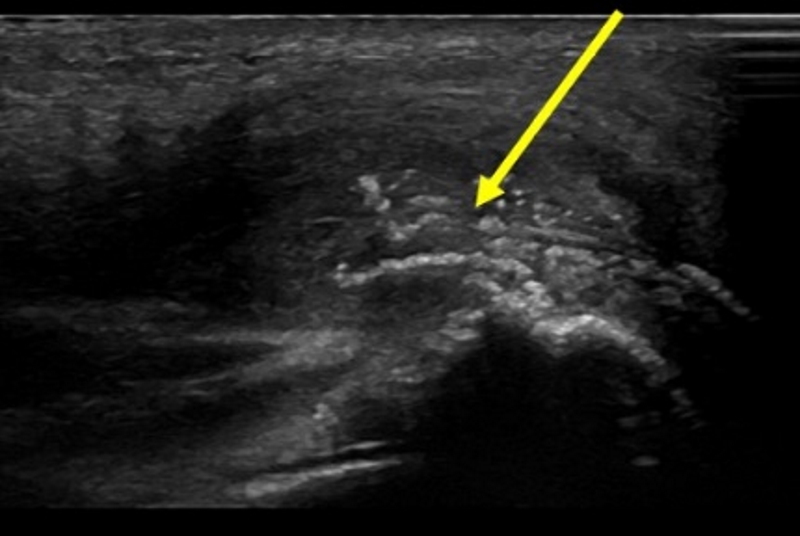A weightlifter’s elbow is often thought to be due to inflammation of the biceps tendon that attaches to the front of the elbow. The triceps tendon is also affected in weightlifters but is at the back of the elbow. What is triceps tendonitis, the forgotten weightlifter’s elbow, and how do we treat it?
What is triceps tendonitis?

The triceps muscle comprises three muscle heads that start at the shoulder and shoulder blade and pass behind the arm. Close to the elbow, the muscle forms the strong triceps tendon that inserts onto the back of the elbow (olecranon). The triceps muscle contracts and extends the elbow.
Generally, repeated muscle contraction – especially in sports – can lead to overload and swelling of the triceps tendon, also known as triceps tendonitis. Occasionally, triceps tendonitis after trauma, such as a fall directly onto the tip of the elbow or an elbow dislocation.
How do you know you have triceps tendonitis?
Generally. symptoms of triceps tendonitis include the following:
- Pain at the tip of the elbow occurs during and after exercises that stress the triceps tendon. Examples of activity include bench press, shoulder press, and push up. Sometimes, pain from triceps tendonitis can warm up as you continue to exercise but worsens after exercise. Occasionally pain can be felt moving up into the middle part of the triceps muscle.
- Swelling or bulging at the tip of the elbow
- People report weakness in pushing exercises – often due to pain and muscle wasting.
Clinical assessment is essential. Your doctor will examine your elbow. Usually, the area of tendon swelling is tender to the touch. Also, you often feel pain with resisted triceps contraction manoeuvres such as resisted triceps extension.
Overall, it is essential to rule out other causes of pain at the back of the elbow, including elbow arthritis, tennis elbow, golfer’s elbow, posterior impingement of the elbow, and olecranon bursitis. Regarding olecranon bursitis, often, this condition is not painful – unlike triceps tendonitis.

In general, imaging confirms triceps tendonitis and rules out these other causes. An X-ray can exclude elbow arthritis. Ultrasound or MRI will confirm triceps tendon swelling and rule out joint and other tendon pathology.
Triceps tendonitis vs tennis elbow: How can you tell?
It is usually relatively easy to tell between triceps tendonitis and tennis elbow. Tennis elbow pain occurs on the outside of the elbow. It is often triggered by lifting heavier objects and not by pressing exercises. Finally, clinical examination demonstrates tenderness outside the elbow, and pain is reproduced by forcing the wrist backwards while resisting. Finally, an ultrasound or MRI can easily differentiate between these two problems if there is any doubt.
Triceps tendonitis treatment
Overall, triceps tendonitis treatment follows the general principles of treating tendonitis. Generally, we try simple treatments combined with isolated exercise therapy.
Firstly, the offending activity should be avoided, modified, or reduced. For example, in weightlifters, we advise reducing the weight of typical pushing exercises at the gym, such as bench press or shoulder press. Sometimes, changing shoulder and chest exercises can help. For example, moving from bench press to dumbell flys or shoulder press to lateral raises can reduce the heavy load on the triceps tendon.
Secondly, simple triceps tendonitis treatment can help reduce pain and swelling. Examples include a short course of ibuprofen and regular ice.
Finally, we suggest GTN patches or shockwave therapy in more complex cases. Recent evidence suggests these treatments reduce pain and allow a faster return to full activity.
Triceps tendonitis exercises


These simple triceps tendonitis treatments are often combined with an exercise for triceps tendonitis to strengthen the tendon and muscle. Usually, we start with isolated triceps exercises such as triceps press down or extension. Then, we gradually increase the weight of the exercise, followed by speed. Finally, we move to compound exercises such as bench press, shoulder press, or more sports-specific activities as pain and function improve.
What happens if you fail exercises for triceps tendonitis? What are your options?
Generally, failure of exercise therapy occurs in a small number. In these cases, we suggest injection therapy to help improve symptoms.
Options for a triceps tendon injection include cortisone, needle tenotomy, or platelet-rich plasma. In general, we suggest avoiding cortisone due to the potentially harmful and weakening effects of cortisone on tendon structure. In addition, little evidence supports using more expensive PRP for triceps tendonitis. Overall, we prefer to perform a needle tenotomy using diluted local anaesthetic and ultrasound to pass a needle 10-20 times through the focal area of tendinosis. This is because we think that the needling of tendinosis triggers acute inflammation, healing, and remodelling.
Finally, you should avoid surgery in almost all cases of triceps tendinosis unless you have failed all other treatments.
Torn triceps tendon: How do you know?
A triceps tendon tear is rare. However, it can occur after a fall directly onto the tendon or tip of the elbow. Also, losing balance during a heavy bench or chest press can stretch and tear the tendon.
Generally, people who suffer a triceps tendon tear will feel intense pain, sometimes accompanied by a pop or tearing sensation. Often, continuing gym or sport is impossible. The elbow swells, and any movement of the elbow is excruciating. In addition, bruising develops at the elbow’s back and can extend into the forearm.
Clinical examination reveals tenderness and swelling at the site of the triceps tendon tear. In addition, there is pain and weakness with testing of triceps strength.
Imaging with ultrasound or MRI will confirm a triceps tendon tear. It is essential to define whether a tear is a full or partial thickness, determining whether surgery is needed. We treat a partial-thickness tear without surgery but with a short period of rest in an elbow brace, graded loading, and the addition of treatments such as GTN patches to help with healing.
Final word from Sportdoctorlondon on triceps tendonitis
Triceps tendonitis is less common than other tendonitis in the elbow, such as tennis or golfer’s elbow. However, we should consider triceps tendonitis in weightlifters or sportspeople with pain in the back of the elbow. Simple triceps tendonitis treatments are tried first. Generally, it would be best to avoid the quick fix of a cortisone shot due to the risk of complete rupture.



I currently have tennis elbow and my physio has told me to do all exercises to failure and to increase weight and do low reps to feel make the muscles around my elbow fatigued. one of the exercises is triceps extensions. is what i’m doing safe and correct?
Hi Cole,
We know that exercise improves tendon pain. But you can do these exercises in various ways – high repetition and low weight or low repetition and high weight. Generally, for upper limb tendon pain, most people respond to the former – high repetition, lower weight. You need to be guided by how your elbow responds to the exercise. If you develop significant pain after heavy loading, try lighter weights with higher repetition.
Lorenzo